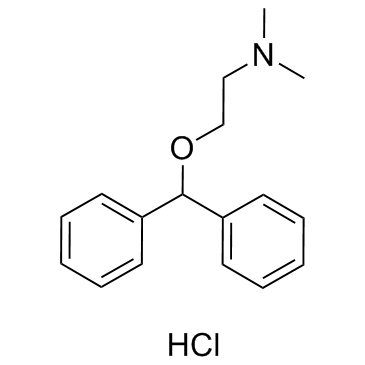Diphenhydramine Hydrochloride

Diphenhydramine Hydrochloride structure
|
Common Name | Diphenhydramine Hydrochloride | ||
|---|---|---|---|---|
| CAS Number | 147-24-0 | Molecular Weight | 291.816 | |
| Density | 1.024g/cm3 | Boiling Point | 343.7ºC at 760 mmHg | |
| Molecular Formula | C17H22ClNO | Melting Point | 168-172 °C | |
| MSDS | Chinese USA | Flash Point | 101.5ºC | |
| Symbol |

GHS07 |
Signal Word | Warning | |
|
Developing structure-activity relationships for the prediction of hepatotoxicity.
Chem. Res. Toxicol. 23 , 1215-22, (2010) Drug-induced liver injury is a major issue of concern and has led to the withdrawal of a significant number of marketed drugs. An understanding of structure-activity relationships (SARs) of chemicals can make a significant contribution to the identification o... |
|
|
A predictive ligand-based Bayesian model for human drug-induced liver injury.
Drug Metab. Dispos. 38 , 2302-8, (2010) Drug-induced liver injury (DILI) is one of the most important reasons for drug development failure at both preapproval and postapproval stages. There has been increased interest in developing predictive in vivo, in vitro, and in silico models to identify comp... |
|
|
Chemical genetics reveals a complex functional ground state of neural stem cells.
Nat. Chem. Biol. 3(5) , 268-273, (2007) The identification of self-renewing and multipotent neural stem cells (NSCs) in the mammalian brain holds promise for the treatment of neurological diseases and has yielded new insight into brain cancer. However, the complete repertoire of signaling pathways ... |
|
|
Age-related pharmacokinetic changes of acetaminophen, antipyrine, diazepam, diphenhydramine, and ofloxacin in male cynomolgus monkeys and beagle dogs.
Xenobiotica 44(10) , 893-901, (2014) 1. The pharmacokinetics of acetaminophen (marker of gastric emptying), antipyrine (marker of hepatic metabolic activity and total body water), diazepam (lipophilic and highly distributed), diphenhydramine (hepatic blood flow-limited and alpha-1 acid glycoprot... |
|
|
Genetic mapping of targets mediating differential chemical phenotypes in Plasmodium falciparum.
Nat. Chem. Biol. 5 , 765-71, (2009) Studies of gene function and molecular mechanisms in Plasmodium falciparum are hampered by difficulties in characterizing and measuring phenotypic differences between individual parasites. We screened seven parasite lines for differences in responses to 1,279... |
|
|
Modeling nociception in zebrafish: a way forward for unbiased analgesic discovery.
PLoS ONE 10(1) , e0116766, (2015) Acute and chronic pain conditions are often debilitating, inflicting severe physiological, emotional and economic costs and affect a large percentage of the global population. However, the development of therapeutic analgesic agents based primarily on targete... |
|
|
Neural peptidase endothelin-converting enzyme 1 regulates endothelin 1-induced pruritus.
J. Clin. Invest. 124(6) , 2683-95, (2014) In humans, pruritus (itch) is a common but poorly understood symptom in numerous skin and systemic diseases. Endothelin 1 (ET-1) evokes histamine-independent pruritus in mammals through activation of its cognate G protein-coupled receptor endothelin A recepto... |
|
|
Drug-polymer intermolecular interactions in hot-melt extruded solid dispersions.
Int. J. Pharm. 443(1-2) , 199-208, (2013) The purpose of the study was to investigate and identify the interactions within solid dispersions of cationic drugs and anionic polymers processed by hot-melt extrusion (HME) technique. Propranolol HCl (PRP) and diphenhydramine HCl (DPD) were used as model c... |
|
|
Endothelial CD99 signals through soluble adenylyl cyclase and PKA to regulate leukocyte transendothelial migration.
J. Exp. Med. 212 , 1021-41, (2015) CD99 is a critical regulator of leukocyte transendothelial migration (TEM). How CD99 signals during this process remains unknown. We show that during TEM, endothelial cell (EC) CD99 activates protein kinase A (PKA) via a signaling complex formed with the lysi... |
|
|
Differential thermodynamic driving force of first- and second-generation antihistamines to determine their binding affinity for human H1 receptors.
Biochem. Pharmacol. 91(2) , 231-41, (2014) Differential binding sites for first- and second-generation antihistamines were indicated on the basis of the crystal structure of human histamine H1 receptors. In this study, we evaluated differences between the thermodynamic driving forces of first- and sec... |